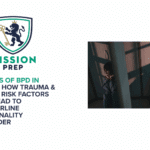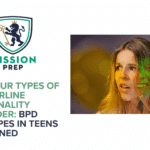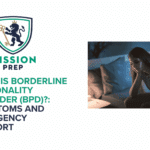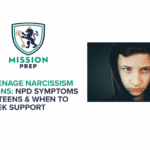Teen BPD Treatment Options: What Therapies are Effective for Teens With BPD?

Most people have a rough ride in their teen years. But throw borderline personality disorder (BPD) into the mix? This condition can make teen years especially tricky. Intense emotions, unstable relationships, impulsivity, and identity confusion. These signs can all surface when a teenager has BPD. And often, this can slip under the radar.
Unfortunately, left untreated, BPD symptoms can grow more severe. Higher rates of self-harm, school difficulties, and even hospitalization are just some of the potential effects. In fact, research shows that adolescents with BPD traits are more likely to attempt suicide than their peers without BPD.¹ Sadly, up to 10% of people with BPD will be successful in their attempts.²
We don’t make these points to scare anyone. Instead, it’s about showing that early intervention matters. Today, there are a wealth of effective teen BPD treatment options out there.
So, whether a teen individual therapy for BPD or a more structured residential BPD treatment, or even outpatient support – these are all available.
This guide can also help by exploring:
- Why BPD requires treatment
- Types of therapy options for BPD teens
- Coping strategies for BPD teens
- How Mission Prep can help with a treatment plan for BPD teens

Why BPD Teens Need Therapy
Borderline personality disorder isn’t just a phase. For teens, it can mean living with daily emotional extremes; feeling abandoned over a delayed text, switching from self-blame to anger in seconds, or struggling to trust that relationships are safe.³ Without structured support, these patterns can affect school, family life, and self-esteem in deeply disruptive ways. This is why therapy for BPD typically isn’t optional; it’s essential.
Many families understandably hesitate when reaching out for support, feeling unsure of what will actually help. But research consistently shows that early, specialized treatment improves outcomes dramatically, especially when it comes to avoiding more challenging personality struggles later on in life.⁴
The best therapy for BPD teens isn’t one-size-fits-all. It blends structure with flexibility, offering space to learn, practice, and recover at a pace that feels doable. Programs that prioritize emotional regulation therapy help teens begin to name and manage intense feelings, while trauma-informed therapy for teens can gently address deeper pain without creating overwhelm.
Therapy also gives teens time to slow down and reflect, with support. Whether through individual therapy for BPD or participation in teen mental health programs, having a trusted space to process emotions helps prevent risky behaviors and build self-trust.⁵ And when therapy is part of a larger, coordinated treatment plan, the impact often extends far beyond symptom management. It can change a trajectory.
Effective BPD treatment for teens helps address:
- Intense, rapidly shifting emotions
- Chronic fear of abandonment and rejection
- Unstable or chaotic relationships
- Impulsive or self-harming behaviors
- Identity confusion or low self-worth
- Difficulty managing stress or conflict
- Underlying trauma or attachment wounds
Best Therapy for BPD Teens
Research shows that there’s no pharmacological approach that’s significantly effective on core BPD symptoms, which highlights why therapy is the go-to treatment option.⁵
There’s no single therapy that works for every teen with BPD, but some approaches have consistently shown strong results. The best therapy for BPD teens combines emotional skill-building with safety, structure, and compassion. Teens need space to explore their emotions without judgment, but they also need tools they can use outside of sessions, especially in moments of distress. The following options have proven to be effective.
Dialectical Behavior Therapy (DBT):
One of the most well-known approaches for BPD, DBT helps teens build concrete skills for emotional regulation, distress tolerance, mindfulness, and managing relationships. It’s structured, practical, and designed to support teens in both therapy and daily life. DBT can be delivered in individual, group, or combined formats.⁶
Mentalization-Based Therapy (MBT):
MBT helps teens learn how to reflect on their own thoughts and feelings – and understand that others may have different inner worlds. This is especially helpful for teens who tend to misinterpret others’ intentions or spiral in social situations. MBT encourages self-awareness without shame.⁷
Schema Therapy:
Schema therapy focuses on early emotional patterns like beliefs about not being good enough or always being abandoned, that continue to shape behavior in harmful ways. For BPD teens, this approach helps identify and shift deep-rooted narratives that drive emotional reactivity and low self-worth.⁸
Transference-Focused Psychotherapy (TFP):
TFP is a psychodynamic approach that focuses on how relational dynamics play out between the teen and the therapist. These patterns often mirror struggles in the teen’s other relationships. Over time, teens learn how to tolerate closeness, express vulnerability, and develop a more integrated sense of self.⁹
Group Interpersonal Therapy (IPT-G):
IPT-G focuses on improving relationship patterns by addressing common social challenges like conflict, role transitions, and grief. Teens explore how they show up in friendships, family dynamics, and peer groups, and learn new ways to connect without fear or defensiveness.¹⁰
Cognitive Behavioral Therapy (CBT):
CBT helps teens identify unhelpful thoughts and beliefs, like I ruin everything or No one really cares, and challenge them with more balanced perspectives. It’s goal-oriented and often includes homework, which can give teens a sense of structure and agency.¹¹
Emotion-Focused Therapy (EFT):
EFT helps teens access and process intense emotions in a safe and supportive setting. Rather than pushing feelings away or reacting impulsively, teens learn to stay present with emotions and respond in healthier, more connected ways. This approach can be powerful for those who feel overwhelmed by shame, grief, or anger.¹²
Trauma-Informed Therapy:
For many teens with BPD, early trauma plays a significant role in how they experience relationships and emotions. Trauma-informed therapy focuses on creating a safe, predictable space where grounding, trust, and pacing are prioritized. It may be woven into many of the therapies above, and is especially important when working with complex trauma or early attachment disruptions.¹³
Therapy Formats for BPD
Therapy can be provided in several formats for BPD, including:
Individual Therapy for BPD
For some teens, especially those who are sensitive to group dynamics or have trust issues, individual therapy for BPD provides a vital foundation. These one-on-one sessions focus on building insight, creating safety, and helping teens understand the patterns behind their reactions. Individual work can also address trauma or early attachment wounds, especially when paired with trauma-informed therapy for teens that moves at the teen’s pace. Therapists often use DBT (dialectical behavioral therapy) and mentalization-based therapy in one-to-one formats to treat BPD.¹⁴
Residential BPD Treatment
If a teen is struggling to stay safe or function at home, residential BPD treatment may be the right step. These live-in programs offer 24/7 structure, therapeutic supervision, and daily opportunities to build coping skills. Many residential settings include emotional regulation therapy, family therapy, and DBT-based skill groups. It’s not a forever plan, but it can be a powerful reset.
Outpatient BPD Programs
Not every teen needs to leave home for treatment. Outpatient BPD programs give teens intensive support while they continue school or home life. These programs typically offer several hours of therapy each week, including group sessions, family involvement, and regular check-ins. It’s an ideal option for teens who need more than weekly therapy but aren’t in crisis.
Coping Strategies for BPD Teens
For teens with BPD, negative emotions can feel entirely overwhelming. They might go from zero to one hundred in a matter of seconds, especially when a friendship feels unstable or a situation feels out of their control. This is why coping strategies for BPD need to be both accessible and repeatable.
In many teen BPD treatment options, especially those rooted in emotional regulation therapy, teens learn how to notice their emotions early, rather than reacting once they’ve already hit boiling point. These tools are often pulled from youth DBT skills training, which teaches teens to recognize urges, reduce reactivity, and tolerate distress without acting impulsively.
Some of the most helpful coping strategies for BPD teens include:
- Using grounding tools: Such as breathwork, cold water, or sensory item, to reset the nervous system
- Name-it-to-tame-it: A technique used for labeling emotions to reduce their intensity
- Radical acceptance: Learning to accept the current moment without fighting it
- Checking the facts: Info gathering before reacting impusively to perceived rejection or threat
- Opposite action: Acting opposite to the urge (for example, reaching out instead of withdrawing)
- Crisis planning: Making an in advance plan for what to do and who to contact during emotional emergencies
These strategies don’t always work perfectly the first time. But when teens have the chance to practice in safe, structured environments like youth DBT groups or outpatient BPD programs, they begin to build confidence. Over time, these coping tools can become the foundation for stronger relationships, fewer outbursts, and a clearer sense of self.

Reach Out to Mission Prep to Set Up a Treatment Plan for BPD Teens
Borderline personality disorder can make everyday life feel unpredictable – both for teens and the families trying to support them. But with the right treatment, things can change. A well-matched treatment plan for BPD teens doesn’t just focus on managing crises. It builds long-term emotional growth, stronger relationships, and a more stable sense of self.
At Mission Prep, we specialize in teen mental health programs that are structured, compassionate, and deeply informed by what BPD teens actually need. From DBT therapy for youth to trauma-informed group support, we help teens build real skills while giving parents the tools and insight to support them through it.
Whether your teen needs outpatient BPD programs or is beginning to explore options for long-term BPD support for youth, we’re here to help guide the next step.
If you’re ready to explore a treatment plan that fits your teen, not just their diagnosis, reach out to Mission Prep today. It could be the first step toward stability, connection, and hope.
References
- Yen, S., Gagnon, K., & Spirito, A. (2013). Borderline personality disorder in suicidal adolescents: Borderline personality disorder in adolescents. Personality and Mental Health, 7(2), 89–101. https://pmc.ncbi.nlm.nih.gov/articles/PMC4414329/
- Paris, J. (2019). Suicidality in borderline personality disorder. Medicina, 55(6), 223. https://pmc.ncbi.nlm.nih.gov/articles/PMC6632023/
- Larrivée, M.-P. (2013). Borderline personality disorder in adolescents: The he-who-must-not-be-named of psychiatry. Dialogues in Clinical Neuroscience, 15(2), 171–179. https://pmc.ncbi.nlm.nih.gov/articles/PMC3811088/
- Bo, S., Sharp, C., Kongerslev, M. T., Luyten, P., & Fonagy, P. (2022). Improving treatment outcomes for adolescents with borderline personality disorder through a socioecological approach. Borderline Personality Disorder and Emotion Dysregulation, 9(1), 16. https://pmc.ncbi.nlm.nih.gov/articles/PMC9199171/
- Bourvis, N., Cohen, D., & Benarous, X. (2023). Therapeutic and preventive interventions in adolescents with borderline personality disorder: Recent findings, current challenges, and future directions. Journal of Clinical Medicine, 12(20), 6668. https://pmc.ncbi.nlm.nih.gov/articles/PMC10607502/
- Fleischhaker, C., Böhme, R., Sixt, B., Brück, C., Schneider, C., & Schulz, E. (2011). Dialectical behavioral therapy for adolescents (DBT-A): A clinical trial for patients with suicidal and self-injurious behavior and borderline symptoms with a one-year follow-up. Child and Adolescent Psychiatry and Mental Health, 5(1), 3. https://pmc.ncbi.nlm.nih.gov/articles/PMC3037874/
- Beck, E., Bo, S., Jørgensen, M. S., Gondan, M., Poulsen, S., Storebø, O. J., Fjellerad Andersen, C., Folmo, E., Sharp, C., Pedersen, J., & Simonsen, E. (2020). Mentalization-based treatment in groups for adolescents with borderline personality disorder: A randomized controlled trial. Journal of Child Psychology and Psychiatry, 61(5), 594–604. https://pubmed.ncbi.nlm.nih.gov/31702058/
- Hilden, H.-M., Rosenström, T., Karila, I., Elokorpi, A., Torpo, M., Arajärvi, R., & Isometsä, E. (2021). Effectiveness of brief schema group therapy for borderline personality disorder symptoms: A randomized pilot study. Nordic Journal of Psychiatry, 75(3), 176–185. https://www.tandfonline.com/doi/full/10.1080/08039488.2020.1826050
- Normandin, L., Weiner, A., & Ensink, K. (2021). Transference-focused psychotherapy for adolescents with personality disorders. Psychodynamic Psychiatry, 49(2), 215–243. https://pubmed.ncbi.nlm.nih.gov/34061646/
- Bozzatello, P., Blua, C., Marin, G., Rocca, P., & Bellino, S. (2023). Group interpersonal psychotherapy (IPT-G) for borderline personality disorder: A randomized controlled study. Journal of Psychiatric Research, 168, 157–164. https://pubmed.ncbi.nlm.nih.gov/37913742/
- Arif, H., Shah, S. U., & Tajummal, A. (2025). Evaluation of the effectiveness of cognitive behavioral therapy on emotional regulation, impulsivity and interpersonal functioning in adolescents with borderline personality traits. Journal of Social Signs Review, 3(5), 340–355. https://socialsignsreivew.com/index.php/12/article/view/276
- Warwar, S. H., Links, P. S., Greenberg, L., & Bergmans, Y. (2008). Emotion-focused principles for working with borderline personality disorder. Journal of Psychiatric Practice, 14(2), 94–104. https://pubmed.ncbi.nlm.nih.gov/18360195/
- Thielemann, J. F. B., Kasparik, B., König, J., Unterhitzenberger, J., & Rosner, R. (2022). A systematic review and meta-analysis of trauma-focused cognitive behavioral therapy for children and adolescents. Child Abuse & Neglect, 131, 105899. https://www.sciencedirect.com/science/article/abs/pii/S0145213422004331
- Stoffers-Winterling, J. M., Storebø, O. J., Simonsen, E., Sedoc Jørgensen, M., Pereira Ribeiro, J., Kongerslev, M. T., & Lieb, K. (2022). Perspectives on dialectical behavior therapy and mentalization-based therapy for borderline personality disorder: Same, different, complementary? Psychology Research and Behavior Management, 15, 3179–3189. https://pmc.ncbi.nlm.nih.gov/articles/PMC9624210/



















